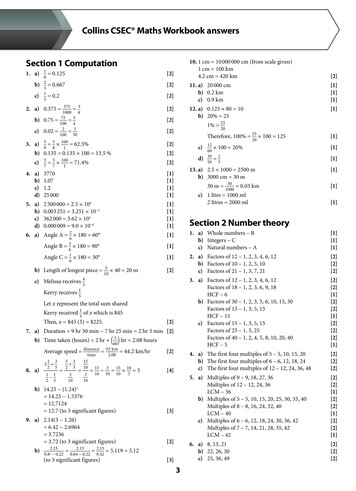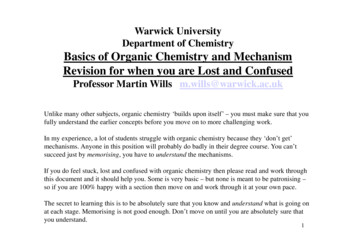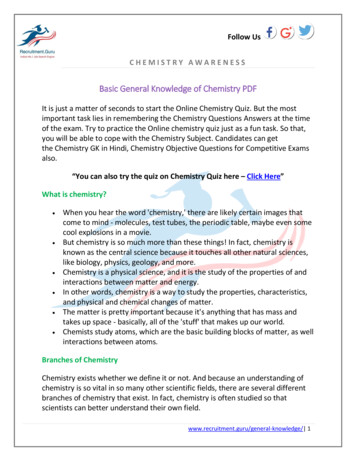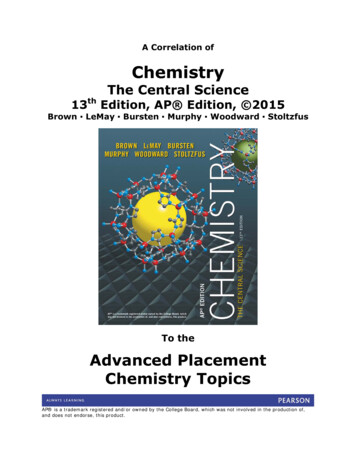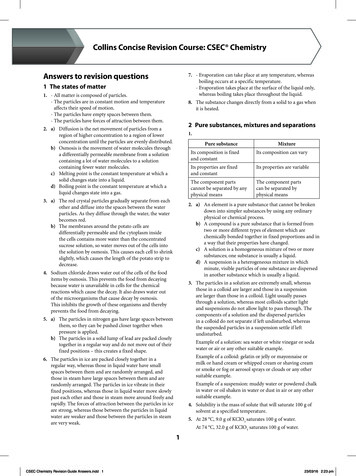
Transcription
Collins Concise Revision Course: CSEC Chemistry7. - Evaporation can take place at any temperature, whereasboiling occurs at a specific temperature.- Evaporation takes place at the surface of the liquid only,whereas boiling takes place throughout the liquid.Answers to revision questions1 The states of matter1. - All matter is composed of particles.- The particles are in constant motion and temperatureaffects their speed of motion.- The particles have empty spaces between them.- The particles have forces of attraction between them.8. The substance changes directly from a solid to a gas whenit is heated.2 Pure substances, mixtures and separations2. a) Diffusion is the net movement of particles from aregion of higher concentration to a region of lowerconcentration until the particles are evenly distributed.b) Osmosis is the movement of water molecules througha differentially permeable membrane from a solutioncontaining a lot of water molecules to a solutioncontaining fewer water molecules.c) Melting point is the constant temperature at which asolid changes state into a liquid.d) Boiling point is the constant temperature at which aliquid changes state into a gas.1.Pure substance3. a) The red crystal particles gradually separate from eachother and diffuse into the spaces between the waterparticles. As they diffuse through the water, the waterbecomes red.b) The membranes around the potato cells aredifferentially permeable and the cytoplasm insidethe cells contains more water than the concentratedsucrose solution, so water moves out of the cells intothe solution by osmosis. This causes each cell to shrinkslightly, which causes the length of the potato strip todecrease.MixtureIts composition is fixedand constantIts composition can varyIts properties are fixedand constantIts properties are variableThe component partscannot be separated by anyphysical meansThe component partscan be separated byphysical means2. a) An element is a pure substance that cannot be brokendown into simpler substances by using any ordinaryphysical or chemical process.b) A compound is a pure substance that is formed fromtwo or more different types of element which arechemically bonded together in fixed proportions and ina way that their properties have changed.c) A solution is a homogeneous mixture of two or moresubstances; one substance is usually a liquid.d) A suspension is a heterogeneous mixture in whichminute, visible particles of one substance are dispersedin another substance which is usually a liquid.4. Sodium chloride draws water out of the cells of the fooditems by osmosis. This prevents the food from decayingbecause water is unavailable in cells for the chemicalreactions which cause the decay. It also draws water outof the microorganisms that cause decay by osmosis.This inhibits the growth of these organisms and therebyprevents the food from decaying.3. The particles in a solution are extremely small, whereasthose in a colloid are larger and those in a suspensionare larger than those in a colloid. Light usually passesthrough a solution, whereas most colloids scatter lightand suspensions do not allow light to pass through. Thecomponents of a solution and the dispersed particlesin a colloid do not separate if left undisturbed, whereasthe suspended particles in a suspension settle if leftundisturbed.5. a) The particles in nitrogen gas have large spaces betweenthem, so they can be pushed closer together whenpressure is applied.b) The particles in a solid lump of lead are packed closelytogether in a regular way and do not move out of theirfixed positions – this creates a fixed shape.Example of a solution: sea water or white vinegar or sodawater or air or any other suitable example.Example of a colloid: gelatin or jelly or mayonnaise ormilk or hand cream or whipped cream or shaving creamor smoke or fog or aerosol sprays or clouds or any othersuitable example.6. The particles in ice are packed closely together in aregular way, whereas those in liquid water have smallspaces between them and are randomly arranged, andthose in steam have large spaces between them and arerandomly arranged. The particles in ice vibrate in theirfixed positions, whereas those in liquid water move slowlypast each other and those in steam move around freely andrapidly. The forces of attraction between the particles in iceare strong, whereas those between the particles in liquidwater are weaker and those between the particles in steamare very weak.Example of a suspension: muddy water or powdered chalkin water or oil shaken in water or dust in air or any othersuitable example.4. Solubility is the mass of solute that will saturate 100 g ofsolvent at a specified temperature.5. At 28 C, 9.0 g of KClO3 saturates 100 g of water.At 74 C, 32.0 g of KClO3 saturates 100 g of water.1CSEC Chemistry Revision Guide Answers.indd 123/03/16 2:23 pm
mass of KClO3 to be added to resaturate a solutioncontaining 100 g of water 32.0 – 9.0 g 23.0 g3 Atomic structure1. An atom is the smallest particle of an element that can existby itself and still have the same chemical properties as theelement.and mass of KClO3 to be added to resaturate a solution23.0containing 350 g of water 100 350 g2. - Protons- Neutrons- Electrons 80.5 gfilter funnel6.Protons and neutrons have a relative mass of 1, whereaselectrons have a relative mass of 1 .filter paper1840solid andliquid mixtureProtons have a relative charge of 1, neutrons have nocharge and electrons have a relative charge of –1.3. a) Atomic number is the number of protons in thenucleus of one atom of an element.b) Mass number is the total number of protons andneutrons in the nucleus of one atom of an element.conical flask4. a) CarbonA carbon atom has 6 protons, 6 neutrons and 6 electronsElectronic configuration is 2,4filtrate – water7. The apparatus would be set up for simple distillation.Tap water would be placed in the distillation flask and itwould be heated so it boils. The steam produced wouldmove into the condenser, where it would condense and thedistillate would run into the conical flask. Any impuritiesin the tap water would remain in the distillation flask.The thermometer would be monitored during the processto ensure the temperature of the steam entering thecondenser remains at the boiling point of pure water, i.e.100 C, thus ensuring the distillate would be pure water.The Liebig condenser, being long and having the waterrunning in the opposite direction to the steam, wouldprovide a permanently cold surface on which the steamwould condense.6p6nb) PotassiumA potassium atom has 19 protons, 20 neutrons and19 electronsElectronic configuration is 2,8,8,119p20n8. a) Cooking oil and water are immiscible and the waterhas a higher density than the oil. When a mixturecontaining both is placed into a separating funnel, theoil floats on the water. By opening the tap of the funnel,the water can be run off into a conical flask, leaving theoil in the funnel.b) The different dyes in a drop of black ink have differentsolubilities in water and are attracted to absorbentpaper with different strengths. When a drop of inkis placed on a piece of absorbent paper and water isallowed to move through the paper, the dye which ismost soluble and least attracted to the paper movesfastest, and the dye which is least soluble and moststrongly attracted to the paper moves slowest.9.cutting andcrushingneutralisation ationvacuumdistillationc) ChlorineA chlorine atom has 17 protons, 18 neutrons and17 electronsElectronic configuration is 2,8,717p18nd) BerylliumA beryllium atom has 4 protons, 5 neutrons and4 electronsElectronic configuration is 2,24p5n2CSEC Chemistry Revision Guide Answers.indd 223/03/16 2:23 pm
5. Isotopy is the occurrence of atoms of a single elementthat have the same number of protons in their nuclei, butdifferent numbers of neutrons.c) Dmitri Mendeleev published his Periodic Classificationof Elements in which he arranged elements inincreasing relative atomic mass, placed elements withsimilar chemical and physical properties togetherin vertical columns, left gaps when it appeared thatelements had not yet been discovered and occasionallyignored the order suggested by relative atomic massand exchanged adjacent elements so they were betterclassified into chemical families. Mendeleev is creditedwith creating the first version of the periodic table.6. a) Naturally occurring boron has two isotopes. Oneisotope, 10 B, has 5 protons, 5 neutrons and 5 electrons5and the other, 11 B, has 5 protons, 6 neutrons and55 electrons.b) Average mass number 20 10 80 11(100) (100) 10.87. Radioactive isotopes are isotopes which have unstablenuclei. These nuclei spontaneously undergo radioactivedecay during which they eject small particles and radiation.2. The elements in the modern periodic table are arrangedon the basis of increasing atomic number, the electronicconfiguration of their atoms and their chemical properties.8. a) Electricity is generated in nuclear power stations usingradioactive uranium-235. If a uranium-235 atom isstruck by a moving neutron, it splits into two smalleratoms. As it splits, two or three neutrons and a largeamount of heat energy are released. The neutrons canthen strike other atoms, causing them to split and releasemore neutrons and energy. This causes a chain reactionwhich releases very large amounts of heat energy thatcan be used to generate electricity.b) The age of a fossil can be determined by carbon-14dating. The percentage of carbon-14 in a livingorganism’s body remains constant at 0.01%. Whenan organism dies, it stops taking in carbon and thepercentage of carbon-14 in its body decreases asit undergoes radioactive decay. By measuring thepercentage of radioactive carbon-14 in the fossil andusing the fact that the half-life of carbon-14 is 5700years, its age can be determined.c) Cancerous cells in tumours can be destroyed bydirecting a controlled beam of radiation fromradioactive cobalt-60 at the cells. Alternatively, aradioactive isotope can be injected directly into thecancerous tumour.3. a) Elements in the same group all have the same numberof valence electrons.b) Elements in the same period all have the same numberof occupied electron shells.9. Relative atomic mass is the average mass of one atom of anelement compared to one-twelfth the mass of an atom ofcarbon-12.8. The metallic nature of the elements decreases.4. Group number of element X is V.Period number of element X is 3.5. Calcium would react more vigorously.Calcium is below magnesium in Group II so has a largeratomic radius. Calcium’s valence electrons are further fromthe attractive pull of the positive nucleus and are moreeasily lost, so it ionises more easily than magnesium.6. The state changes from gas to liquid to solid. The top twoelements are gases at room temperature, the one below is aliquid and the one below that is a solid.7. A reaction would occur.Chlorine is above bromine in group VII so it has a smalleratomic radius and the attractive pull of the positive nucleuson the electron to be gained is stronger in chlorine. As aresult, chlorine has a greater strength of oxidising powerand readily takes electrons from the Br– ions causing themto be converted to bromine atoms.9. Chlorine would be more reactive.Chlorine is to the right of sulfur in Period 3, so it has asmaller atomic radius and one more positive proton. Theattractive pull of the positive nucleus on the electron tobe gained is stronger in chlorine, therefore it ionises moreeasily than sulfur.Relative atomic mass is used to determine the mass ofatoms because atoms are so small their absolute masses arevery difficult to measure. By using relative atomic masstheir masses can be compared.4 The periodic table and periodicity5 Structure and bonding1. a) Johann Döbereiner proposed the Law of Triads. Henoticed that certain groups of three elements, whichhe called triads, showed similar chemical and physicalproperties, and if the elements in any triad werearranged in increasing relative atomic mass, the relativeatomic mass of the middle element was close to theaverage of the first and third elements.b) John Newlands proposed the Law of Octaves. Hearranged the elements that had been discovered at thetime in order of increasing relative atomic mass andfound that each element exhibited similar chemical andphysical properties to the element eight places ahead ofit in the list.1. Elements form compounds to fill their outer valenceelectron shells and become stable.2. - Ionic bonding.- Covalent bonding.- Metallic bonding.3. a)b)c)d)e)f)g)ZnCl2 – ionic bonding.Mg3(PO4)2 – ionic bonding.SiF4 – covalent bonding.CS2 – covalent bonding.(NH4)2CO3 – ionic bonding.Al(OH)3 – ionic bonding.K2SO4 – ionic bonding.3CSEC Chemistry Revision Guide Answers.indd 323/03/16 2:23 pm
4. a) Type of compound: ionicIons present: Na , O2–Formula: Na2OH NaNaCO HNa2 sodium atoms 1 oxygen atom2 sodium ions1 carbonatomPFFFFF3 fluorineatoms1 phosphorus trifluoridemoleculec) Type of compound: ionicIons present: Ca2 , N3–Formula: Ca3N2Ca3–NN2 Ca3–N3 calciumatomsCa2 nitrogenatoms3 calciumions1 methanemolecule9. a) The partial negative ends of polar water moleculesattract the positive Na ions and the partial positiveends attract the negative Cl– ions in the sodiumchloride crystal. This pulls the ions out of the latticecausing the crystal to dissolve.b) Diamond is extremely hard because strong covalentbonds exist between the carbon atoms throughout thestructure.c) The fourth valence electron from each carbon atom ingraphite is delocalised and free to move and carry theelectricity.d) The weak forces that exist between the layers of carbonatoms in graphite allow the layers to slip off and leavedark marks on the paper.2 Ca4 hydrogenatoms8. Allotropy is the existence of different structural forms of asingle element in the same physical state.CaNH7. Ionic solids have high melting points, whereas simplemolecular solids have low melting points. Most ionic solidsare soluble in water but insoluble in non-polar organicsolvents, whereas most simple molecular solids are solublein non-polar organic solvents but insoluble in water. Ionicsolids do not conduct electricity in the solid state, but theydo conduct electricity when they are molten or dissolvedin water, whereas simple molecular solids do not conductelectricity in any state.2 CaH5. The magnesium atoms are packed tightly together in rowsto form a metal lattice and their valence electrons becomedelocalised. This forms positive magnesium cations and asea of mobile electrons. The metal lattice is held togetherby the electrostatic forces of attraction between thedelocalised electrons and the magnesium cations called themetallic bond.6. a) The strong electrostatic forces of attraction between thecations and delocalised electrons require large amountsof heat energy to break.b) The delocalised electrons are free to move and carryelectricity through the metal.c) The atoms of a metal are all of the same type and size,so if force is applied the atoms can slide past each otherinto new positions without the metallic bond breaking.FPCH1 oxide ionb) Type of compound: covalentValencies: P 3, F 1Formula: PF31 phosphorusatomsHONaHH2–2 nitrideionsd) Type of compound: covalentValencies: C 4, H 1Formula: CH44CSEC Chemistry Revision Guide Answers.indd 423/03/16 2:23 pm
8 The mole concept6 Chemical equations1. a) Br2(aq) 2KI(aq)1. a) Relative atomic mass is the average mass of one atomof an element compared to one twelfth the mass of anatom of carbon-12.b) A mole is the amount of a substance that contains6.0 1023 particles of the substance.c) Molar mass is the mass, in grams, of one mole of achemical substance.d) Molar volume is the volume occupied by onemole of a gas.2KBr(aq) I2(aq)b) 2Fe(s) 3Cl2(g)2FeCl3(s)c) 2Al(s) 3H2SO4(aq)d) C2H4(g) 3O2(g)Al2(SO4)3(aq) 3H2(g)2CO2(g) 2H2O(g)e) 2NaOH(aq) (NH4)2SO4(aq)Na2SO4(aq) 2NH3(g) 2H2O(l)2. a)b)c)d)e)silver nitrate – solublepotassium phosphate – solublezinc hydroxide – insolublealuminium sulfate – solublelead(II) chloride – insoluble in cold water, moderatelysoluble in hot waterf) copper(II) oxide – insolubleg) calcium carbonate – insolubleh) sodium ethanoate – soluble2. a) Mass of 1 mol (NH4)3PO4 (3 14) (3 4 1) 31 (4 16) g 149 g mass of 0.3 mol (NH4)3PO4 0.3 149 g 44.7 gb) Mass of 1 mol CuSO4 64 32 (4 16) g 160 g number of moles in 3.2 g CuSO4 3.2 mol3. a) Mg(OH)2(s) 2HNO3(aq)Mg(NO3)2(aq) 2H2O(l)160 0.02 molc) 1 mol Al2O3 contains 6.0 1023 Al2O3 formula units number of moles in 2.4 1022 Al2O3 formula unitsb) Pb(NO3)2(aq) 2NaCl(aq)PbCl2(s) 2NaNO3(aq)22 2.4 1023 molc) Ca(HCO3)2(aq) 2HCl(aq)CaCl2(aq) 2CO2(g) 2H2O(l)d) 2Zn(NO3)2(s)6.0 10 0.04 mold) Mass of 1 mol CO2 12 (2 16) g 44 g number of moles in 11 g 11 mol2ZnO(s) 4NO2(g) O2(g)4. 1a) Br2(aq) 2K (aq) 2I–(aq)2K (aq) 2Br–(aq) I2(aq)44 0.25 mol1 mol CO2 contains 6.0 1023 CO2 molecules 0.25 mol CO2 contains 0.25 6.0 1023 CO2molecules 1.5 1023 CO2 molecules–Ionic equation: Br2(aq) 2I (aq)2Br–(aq) I2(aq)1c) 2Al(s) 6H (aq) 3SO42–(aq)2Al3 (aq) 3SO42–(aq) 3H2(g)Ionic equation: 2Al(s) 6H (aq)2Al3 (aq) 3H2(g)3. Equal volumes of all gases, under the same conditions oftemperature and pressure, contain the same number ofmolecules.1e) 2Na (aq) 2OH–(aq) 2NH4 (aq) SO42–(aq)2Na (aq) SO42–(aq) 2NH3(g) 2H2O(l)4. a) Volume of 1 mol O2 at stp 22 400 cm3 –Ionic equation: OH (aq) NH4 (aq)NH3(g) H2O(l) number of moles in 560 cm3 2 – PbCl2(s)–3c) Ca (aq) 2HCO3 (aq) 2H (aq) 2Cl (aq)Ca2 (aq) 2Cl–(aq) 2CO2(g) 2H2O(l)Ionic equation: HCO3–(aq) H (aq)CO2(g) H2O(l)17 0.2 molVolume of 1 mol NH3 at rtp 24.0 dm3 volume of 0.2 mol NH3 0.2 24.0 dm3 4.8 dm3d) Volume of 1 mol H2 at stp 22.4 dm37 Types of chemical reaction1. a)b)c)d)e)f)mol 0.025 molb) Volume of 1 mol CO at rtp 24.0 dm3 volume of 0.15 mol CO 0.15 24.0 dm3 3.6 dm3c) Mass of 1 mol NH3 14 (3 1) g 17 g number of moles in 3.4 g NH3 3.4 mol3b) Pb2 (aq) 2NO3–(aq) 2Na (aq) 2Cl–(aq)PbCl2(s) 2Na (aq) 2NO3–(aq)Ionic equation: Pb2 (aq) 2Cl–(aq)56022 400Displacement reaction.Synthesis reaction.Neutralisation reaction.Decomposition reaction.Ionic precipitation reaction.Displacement reaction. number of moles in 1.68 dm3 1.68 mol22.4 0.075 mol1 mol H2 contains 6.0 1023 H2 molecules 0.075 mol H2 contains 0.075 6.0 1023 H2molecules 4.5 1022 H2 molecules5CSEC Chemistry Revision Guide Answers.indd 523/03/16 2:23 pm
Mass of 1 mol NaOH 23 16 1 g 40 g5. a) Mass of oxygen in the compound 56.0 – (23.0 18.9) g 14.1 gElementMassMass of 1moleNumber ofmolesSimplestmole ratioKSO23.0 g18.9 g14.1 g39 g32 g16 g23.039mol18.93214.116mol number of moles in 3.3 g 3.3 mol40 0.0825 molc) 400 cm3 Ca(NO3)2(aq) contains 32.8 g Ca(NO3)2 1000 cm3 Ca(NO3)2(aq) contains32.8400mol 0.59 mol 0.59 mol 0.88 mol1 mol1 mol1.5 molMass of 1 mol Ca(NO3)2 40 (2 14) (2 3 16) g 164 g 2 mol 2 mol 3 mol number of moles in 82.0 g 82.0 mol164 0.5 molMolar concentration of the solution 0.5 mol dm–3Empirical formula is K2S2O3b)ElementCHBrPercentage22.2%3.7%74.1%Mass in100 g22.2 g3.7 g74.1 gMass of 1moleNumber ofmolesSimplestmole ratio 1000 g Ca(NO3)2 82.0 g Ca(NO3)212 g22.212mol1g3.71mol 1.85 mol 3.7 mol2 mol9. Matter can neither be created nor destroyed during achemical reaction.10. 3KOH(aq) H3PO4(aq)25.2 g number of moles in 25.2 g KOH 25.2 mol56mol 0.45 mol 0.93 mol4 mol? massMass of 1 mol KOH 39 16 1 g 56 g80 g74.180K3PO4(aq) 3H2O(l)3 mol KOH form 1 mol K3PO41 mol 0.45 mol KOH forms 1 0.45 mol K3PO43 0.15 mol K3PO4Empirical formula is C2H4BrRelative molecular mass of C2H4Br (2 12) (4 1) 80 108Mass of 1 mol K3PO4 (3 39) 31 (4 16) g 212 gRelative molecular mass of compound 216and ratio between relative molecular masses 216 mass of 0.15 mol K3PO4 0.15 212 g 31.8 g10811. 2H2(g) O2(g)? volumeat stp 2 the molecular formula is 2 the empirical formulaMolecular formula of the compound is C4H8Br22H2O(g)672 cm3Volume of 1 mol H2O(g) at stp 22 400 cm36. Mass of 1 mol Pb(NO3)2 207 (2 14) (2 3 16) g 331 g number of moles in 672 cm3 H2O(l) 67222 400mol 0.03 molMass of oxygen in 1 mol Pb(NO3)2 2 3 16 g 96 g1 mol O2 forms 2 mol H2O 1 0.03 mol O2 forms 0.03 mol H2O percentage of oxygen in Pb(NO3)2 96 100%3312 0.015 mol O2 29.0%7. A solution whose concentration is known accurately.Volume of 1 mol O2 at stp 22 400 cm38. a) 1000 cm3 K2CO3(aq) contains 0.2 mol K2CO3 volume of 0.015 mol O2 0.015 22 400 cm3 336 cm3 250 cm3 K2CO3(aq) contains0.2 250 mol K2CO3100012. Zn(s) 2HCl(aq)25 cm32.4 mol dm3 0.05 mol K2CO3Mass of 1 mol K2CO3 (2 39) 12 (3 16) g 138 g1000 cm3 HCl(aq) contains 2.4 mol HClMass of 0.05 mol K2CO3 0.05 138 g 6.9 g 25 cm3 HCl(aq) contains2.41000 25 mol HCl 0.06 mol HClMass of potassium carbonate required 6.9 g2 mol HCl form 1 mol ZnCl2b) 1000 cm3 NaOH(aq) contains 16.5 g NaOH 200 cm3 NaOH(aq) containsZnCl2(aq) H2(g)? mass 0.06 mol HCl forms 1 0.06 mol ZnCl216.5 200 g NaOH10002 0.03 mol ZnCl2 3.3 g NaOH6CSEC Chemistry Revision Guide Answers.indd 623/03/16 2:23 pm
5. a) An acid anhydride is a compound that reacts withwater to form an acid.b) Any two of the following:- Carbon dioxide- Sulfur dioxide- Sulfur trioxide- Nitrogen dioxideMass of 1 mol ZnCl2 65 (2 35.5) g 136 g mass of 0.03 mol ZnCl2 0.03 136 g 4.08 g13. Na2CO3(aq) 2HNO3(aq)2NaNO3(aq) CO2(g) H2O(l)350 cm2.0 mol dm–3? volumeat rtp6. a) The citric acid in the lime juice reacts with the iron(III)oxide in the rust stains. The reaction makes a solublecompound which washes out of the clothes, removingthe rusty yellow Fe3 ions.b) The ethanoic acid in vinegar gives it a low pH whichdenatures the enzymes that cause decay and inhibitsthe growth of microorganisms which also cause decay.31000 cm HNO3(aq) contains 2.0 mol HNO3 50 cm3 HNO3(aq) contains2.01000 50 mol HNO3 0.1 mol HNO32 mol HNO3 form 1 mol CO2 0.1 mol HNO3 forms 1 0.1 mol CO227. a) Hydrochloric acid – pH 0, 1 or 2Ethanoic acid – pH 5 or 6b) Hydrochloric acid is a strong acid which is fully ionisedwhen dissolved in water. Its solution contains a highconcentration of H ions.Ethanoic acid is a weak acid which is only partiallyionised when dissolved in water. Its solution contains alow concentration of H ions. 0.05 mol CO2Volume of 1 mol CO2 at rtp 24.0 dm3 volume of 0.05 mol CO2 0.05 24.0 dm3 1.2 dm314. 2Mg(NO3)2(aq)5.92 g2MgO(s) 4NO2(g) O2(g)? massMass of 1 mol Mg(NO3)2 24 (2 14) (2 3 16) g 148 g number of moles in 5.92 g KOH 5.921488. a) A base is a proton donor.b) An alkali is a base which dissolves in water to form asolution that contains OH– ions.mol 0.04 mol9. Any four of the following:- Alkalis have a bitter taste.- Alkalis are corrosive.- Alkalis feel soapy.- Alkalis change red litmus to blue.- Alkalis have a pH value greater than 7.- Alkalis conduct an electric current or alkalis areelectrolytes.2 mol Mg(NO3)2 form 2 mol MgO 0.04 mol Mg(NO3)2 forms 0.04 mol MgOMass of 1 mol MgO 24 16 g 40 g mass of 0.04 mol MgO 0.04 40 g 1.6 gDecrease in mass 5.92 – 1.6 g 4.32 g10. a) MgO(s) 2NH4NO3(s)Mg(NO3)2(s) 2NH3(g) H2O(l)b) 2NaOH(s) (NH4)2SO4(s)Na2SO4(s) 2NH3(g) 2H2O(l)9 Acids, bases and salts11. - Acidic oxidesAcidic oxides are oxides of some non-metals which reactwith alkalis to form a salt and water.Example: carbon dioxide or sulfur dioxide or sulfurtrioxide or nitrogen dioxide or silicon dioxide.1. When an acid dissolves in water its molecules ionise toform H ions and negative anions. The H ions are singleprotons and when an acid reacts it gives its H ions orprotons to the other reactant.2. Any four of the following:- Acids have a sour taste.- Acids are corrosive.- Acids change blue litmus to red.- Acids have a pH value of less than 7.- Acids conduct an electric current or acids are electrolytes.- Basic oxidesBasic oxides are oxides of metals which react with acids toform a salt and water.Example: potassium oxide or sodium oxide or calciumoxide or magnesium oxide or iron(II) oxide or iron(III)oxide or copper(II) oxide or any other metal oxide exceptaluminium oxide, zinc oxide and lead(II) oxide.3. a) K2CO3(aq) 2HNO3(aq)2KNO3(aq) CO2(g) H2O(l)b) 2NaOH(aq) H2SO4(aq)Na2SO4(aq) 2H2O(l)c) Ca(s) 2HCl(aq)CaCl2(aq) H2(g)d) Mg(HCO3)2(aq) H2SO4(aq)MgSO4(aq) 2CO2(g) 2H2O(l)4. a)b)c)d)- Amphoteric oxidesAmphoteric oxides are oxides of some metals whichreact with both acids and strong alkalis to form a salt andwater.Example: aluminium oxide or zinc oxide or lead(II) oxide.CO2(g) H2O(l)CO32–(aq) 2H (aq)OH–(aq) H (aq)H2O(l)Ca(s) 2H (aq)Ca2 (aq) H2(g)– HCO3 (aq) H (aq)CO2(g) H2O(l)- Neutral oxidesNeutral oxides are oxides of some non-metals which donot react with acids or alkalis.Example: carbon monoxide or nitrogen monoxide ordinitrogen monoxide.7CSEC Chemistry Revision Guide Answers.indd 723/03/16 2:23 pm
12. A salt is a compound formed when some or all ofthe hydrogen ions in an acid are replaced by metal orammonium ions.- Calcium sulfateUsed to manufacture plaster of Paris which is used as abuilding material or to make orthopaedic casts for settingbroken bones.- Magnesium sulfateUsed for various medicinal purposes, for exampleto relieve stress or ease aches and pains or reduceinflammation or cure skin problems or as a laxative.Or used in agriculture to improve plant growth.13. A normal salt is formed when all of the hydrogen ions inan acid are replaced by metal or ammonium ions. Example:any metal chloride or any metal nitrate or any metalethanoate or any metal sulfate or any metal carbonate orany metal phosphate.An acid salt is formed when the hydrogen ions in anacid are only partially replaced by metal or ammoniumions. Example: any metal hydrogensulfate or any metalhydrogencarbonate or any metal hydrogenphosphate orany metal dihydrogenphosphate.17. a) A neutralisation reaction is a reaction between a baseand an acid to form a salt and water.b) The neutralisation point is the point in a neutralisationreaction where the OH– ions from the alkali have fullyreacted with the H ions from the acid and neither ionis present in excess.14. Water of crystallisation is a fixed proportion of watermolecules held within the crystal lattice of some salts.18. Tooth decay is caused by acid in the mouth reacting withthe calcium hydroxyapatite in tooth enamel. Toothpastecontains sodium hydrogencarbonate and sodiummonofluorophosphate. The sodium hydrogencarbonateneutralises any acid present in the mouth and the F– ions inthe sodium monofluorophosphate displace the OH– ions inthe calcium hydroxyapatite, forming calcium fluoroapatite.Calcium fluoroapatite which does not react with acid, sothe tooth enamel is protected from decaying.15. a) Add the zinc carbonate to nitric acid untileffervescence stops and there is excess zinc carbonatepresent. Dip a piece of blue litmus paper into thesolution; it should remain blue. Filter the mixture toremove the excess carbonate, collect the filtrate andevaporate the water, or evaporate some water and leaveto crystallise.ZnCO3(s) 2HNO3(aq)Zn(NO3)2(aq) CO2(g) H2O(l)19. Na2CO3(aq) 2HCl(aq)15.0 cm37.5 cm353.0 g dm–3 2.0 mol dm–3b) Dissolve barium nitrate and either potassium sulfateor sodium sulfate in distilled water to make twosolutions. Mix the solutions to form a precipitate andfilter the mixture to separate the precipitate. Wash theprecipitate (residue) with distilled water and leave itto dry.1000 cm3 Na2CO3(aq) contains 53.0 g Na2CO3 15.0 cm3 Na2CO3(aq) contains 15.0 g Na2CO3Mass of 1 mol Na2CO3 (2 23) 12 (3 16) g 106 gNumber of moles in 0.795 g Na2CO3 0.795 mol Na2CO3c) Measure a fixed volume of potassium hydroxidesolution using a pipette, run it into a conical flaskand add a suitable indicator. Place sulfuric acid intoa burette and perform a titration to determine thevolume of acid needed to neutralise the fixed volumeof potassium hydroxide solution. Add the volume ofacid determined in the titration to the fixed volume ofpotassium hydroxide solution without the indicator.Evaporate the water from the solution, or evaporatesome water and leave to crystallise.106 0.0075 mol Na2CO31000 cm3 HCl(aq) contains 2.0 mol HCl 7.5 cm3 HCl(aq) contains2.01000 7.5 mol HCl 0.015 mol HCl0.0075 mol Na2CO3 reacts with 0.015 mol HCl 1 mol Na2CO3 reacts with 2 mol HCl20. 2NaOH(aq) H2SO4(aq)40.0 cm325.0 cm3? concentration 0.2 mol dm–3K2SO4(aq) 2H2O(l)d) Heat a sample of iron in a stream of chlorine gas in afume cupboard.2Fe(s) 3Cl2(g)53.01000 0.795 g Na2CO3Ba(NO3)2(aq) Na2SO4(aq)BaSO4(s) 2NaNO3(aq)2KOH(aq) H2SO4(aq)2NaCl(aq) CO2(g) H2O(l)Na2SO4(aq) 2H2O(l)1000 cm3 H2SO4(aq) contains 0.2 mol H2SO4 25.0 cm3 H2SO4(aq) contains2FeCl3(s)0.21000 25.0 mol H2SO4 0.005 mol H2SO416. Any four of the following:2 mol NaOH react with 1 mol H2SO4- Sodium hydrogencarbonateUsed as a component of baking powder to make cakesrise.- Calcium carbonateUsed to manufacture cement for use in the constructionindustry.- Sodium chloride or sodium nitrate or sodium nitrite orsodium benzoateUsed to preserve food. 2 0.005 mol NaOH reacts with 0.005 mol H2SO4 0.01 mol NaOH40.0 cm3 NaOH contains 0.01 mol NaOH 1000 cm3 NaOH(aq) contains 0.01 1000 mol NaOH40.0 0.25 mol NaOHMass of 1 mol NaOH 23 16 1 g 40 g8CSEC Chemistry Revision Guide Answers.indd 823/03/16 2:23 pm
mass of 0.25 mol NaOH 0.25 40 g 10.0 gCH4C 4( 1) 0C ( 4) 0Oxidation number of carbon –4Mass concentration of NaOH(aq) 10.0 g dm–3C3H63C 6( 1) 03C ( 6) 03C –6Oxidation number of carbon –210 Oxidation-reduction reactions1. a) Oxidation is the loss of electron
Collins Concise Revision Course: CSEC Chemistry Answers to revision questions 1 The states of matter 1. - All matter is composed of particles. - The particles are in constant motion and temperature affects their speed of motion. - The particles have empty spaces between them. -

